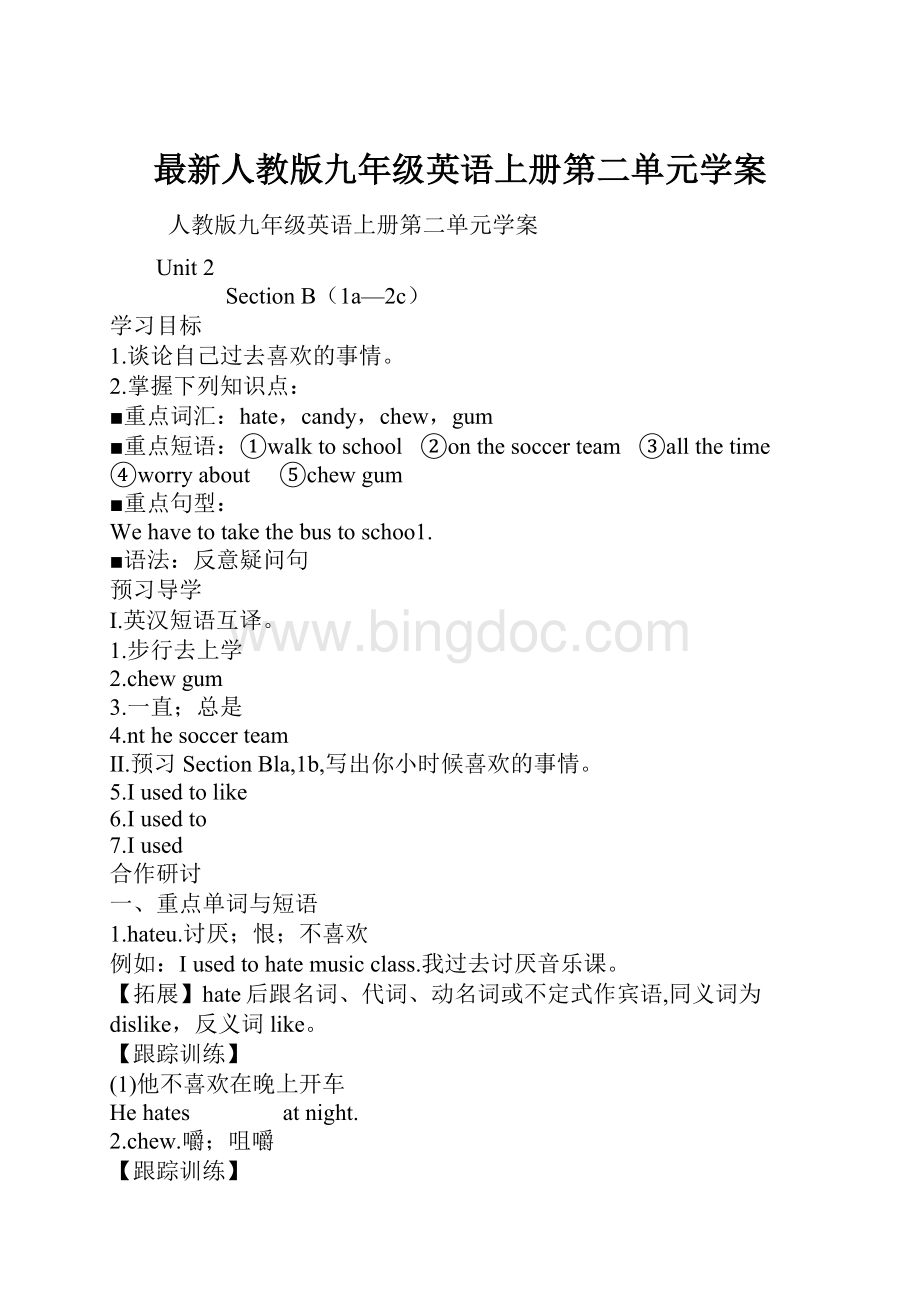最新人教版九年级英语上册第二单元学案.docx
《最新人教版九年级英语上册第二单元学案.docx》由会员分享,可在线阅读,更多相关《最新人教版九年级英语上册第二单元学案.docx(12页珍藏版)》请在冰点文库上搜索。

最新人教版九年级英语上册第二单元学案
人教版九年级英语上册第二单元学案
Unit2
SectionB(1a—2c)
学习目标
1.谈论自己过去喜欢的事情。
2.掌握下列知识点:
■重点词汇:
hate,candy,chew,gum
■重点短语:
①walktoschool ②onthesoccerteam ③allthetime
④worryabout ⑤chewgum
■重点句型:
Wehavetotakethebustoschoo1.
■语法:
反意疑问句
预习导学
Ⅰ.英汉短语互译。
1.步行去上学
2.chewgum
3.一直;总是
4.nthesoccerteam
Ⅱ.预习SectionBla,1b,写出你小时候喜欢的事情。
5.Iusedtolike
6.Iusedto
7.Iused
合作研讨
一、重点单词与短语
1.hateu.讨厌;恨;不喜欢
例如:
Iusedtohatemusicclass.我过去讨厌音乐课。
【拓展】hate后跟名词、代词、动名词或不定式作宾语,同义词为dislike,反义词like。
【跟踪训练】
(1)他不喜欢在晚上开车
Hehates atnight.
2.chew.嚼;咀嚼
【跟踪训练】
(2)吃饭要细嚼慢咽。
Youmust yourfoodwellbeforeyouswallowit.
3.worryabout担心;焦虑
【拓展】与beworriedabout同义
【跟踪训练】
(3)不要担心她。
Don't her.
二、重点句型与语法
■句型
Wehavetotakethebustoschoo1.
我们不得不乘公共汽车去上学。
【精解】①haveto意为“必须;不得不”,后跟动词原形。
【辨析】haveto/must
haveto具有客观性,不以人的主观意志为转移;而must强调主观性。
haveto可以用于各种时态,而must则不能。
【跟踪训练】
(4)他不得不早起赶早班车。
He getupearlytocatchtheearlybus。
(5)我们必须学好英语。
We learn English .
【精解】②takethebus意为“乘公共汽车”,“take+the+交通工具”,相当于“by+交通工具”。
【跟踪训练】
(6)gotoschoolbybuseveryday.(同义句转换)
I toschoo1everyday.
■语法
反意疑问句
反意疑问句,表示说话人提出某种情况或建议,询问对方是否同意。
(1)反意疑问句的结构
反意疑问句是由“陈述句+反意疑问部分”构成,其反意疑问部分的结构是:
be动词/助动词/情态动词+主语。
否定形式要用缩略形式。
①主句为肯定陈述句,反意疑问部分为否定形式,即“前肯后否”式。
【跟踪训练】
(7)Youareastudent, ?
②主句为否定陈述句,反意疑问部分为肯定形式,即“前否后肯”式。
【跟踪训练】
(8)Hehasn'tfinishedhishomework, ?
(2)反意疑问部分的主语和谓语的确定
①反意疑问部分的主语用代词而不用名词。
【跟踪训练】
(9)Mybrotherlikesplayingbasketball, ?
②陈述句中含有否定意义的词,如little,few,never,hardly,nothing,nobody等,其反意疑问部分用肯定形式。
【跟踪训练】
(10)HeknowslittleEnglish, ?
③陈述句是“therebe”结构时,其反意疑问部分用“be+there"。
【跟踪训练】
(11)Thereisapostofficeneartheschool, ?
④以Let's开头的祈使句,反意疑问部分为shallwe;以Letus开头的祈使句,反意疑问部分为willyou;主句为祈使句,反意疑问部分为willyou。
【跟踪训练】
(12)Let'sgohome, ?
(13)Don'tbelateagain, ?
⑤陈述句中含有情态动词must时,若must表示“必须”时,反意疑问部分用needn't。
若must表示推测“一定;想必”之意时,其反意疑问部分的动词应根据must后面的动词来确定。
【跟踪训练】
(14)Wemustworkhard, ?
(15)Shemusthavefinishedherhomework, ?
⑥当陈述句为含有宾语从句的主从复合句时,反意疑问部分的动词和主语通常与主句的动词和主语保持一致。
若主句的主语是第一人称I/we,其谓语动词又是think,sup-pose,believe,imagine等,则反意疑问部分的主语和动词应与从句的主语和动词保持一致。
【跟踪训练】
(16)TomsaidthathewouldvisitChinanextmonth, ?
(17)Ithinkshecansolvetheproblem, ?
(3)反意疑问句的答语
应根据具体的语言环境确定用肯定回答或否定回答,即根据事实回答。
对“前否后肯”式的反意疑问句的回答要注意其回答形式要一致,即肯定用Yes,后面的部分用肯定形式,Yes译为“不”;否定用No,后面的部分用否定形式,No意为“是的”。
【跟踪训练】
(18)—Yourfatherisn'tadoctor,ishe?
- (不,他是).
当党检测
Ⅰ.根据句意及首字母或汉语提示完成单词
1.Iusedtoc gumalot.Whataboutyou?
2.一Doyoulike (糖果)?
一No,Idon't.
3.Somestudentsusuallygotoschoolon (步行).
4.Sheusedto (讨厌)gymclass.
5.HeisabasketballP .
Ⅱ.根据汉语提示完成句子
6.Idon't (担心)tests.
7.LiLeioften (乘公共汽车)toschool.
8.She (不得不)lookafterherlittlebrotherbecausehermotherisn'tathome.
课后练习
Ⅰ.单项选择
( )1.Tomplaysbasketballwellandheis thebasketballteam.
A.in B.on C.at D.with
( )2.Ifyouarefamous,peoplewillfollowyou .
A.allthetime B.thealltimeC.a11time D.timeall
( )3.Heusedtoplayping-pang, .
A.don'the B.didn'the C.wasn'the D.doesn'the
( )4.—Youarenewhere, . —Yes,Icameherelastyear.
A.doyou B.don'tyou C.areyou D.aren'tyou
( )5.—Billhadnothingforbreakfastthismorning ?
— ,hegotuptoolate.
A.hadhe;Yes B.hadn'the;Yes C.didhe;No D.didn'the;No
Ⅱ.阅读理解
IttookJohnmanymonthstosaveup(积蓄)sevenpounds.Hewantedtobuyanewmodelplaneandwenttotheshopwiththemoney.
Ontheway,johnsawalittleboycryingonthecornerofthestreet.“Whyareyoucrying?
”Johnasked.
“Threebigboystookawayfourpoundsfrommejustnow,”theboysaid.”Iwasonmywaytobuysomeexercisebooks,butIcan't.”
Johnthoughtofthesevenpoundsinhispocket.Hethoughtofthemodelplaneandthepoorboy.
Johnwantedtowalkaway,buthedidnot.Atlasthegavefourpoundstotheboyandwenthome.
Johnfelthappy.Doyouknowwhy?
Itwasbecausethelittleboywashappy.
根据短文内容填空
Johnspentmany 6 saving 7 sevenpounds.He 8 tobuyanewmodelplane.Onthewaytothe 9 ,hesawaboy 10 .Theboy 11 Johnthatthreeboyshadtakenawayfourpoundsfromhim,andhecouldn't 12 someexercisebooks.
13 lastJohngave 14 fourpounds.Johndidn'tbuythe 15 plane,buthefelthappyallthesame.
6. 7. 8. 9. 10.
11. 12. 13. 14. 15.
Unit2
SectionB(3a—4a)
学习目标:
1.谈论自己存在的问题。
2.掌握下列知识点:
■重点词汇:
chat,daily,comic
■重点短语:
①a11day②not...anymorechatwith④inthelastfewyears⑤thesedays
■重点句型:
①WhenIwasyoung,Iusedtohavesomuchtime,butthesedaysIgetupearlyandstayinschoo1a11day.
②BeforeIstartedhighschoo1,Iusedtospenda1otoftimeplayinggameswithmyfriends,butIjustdon'thavethetimeanymore.
预习导学
Ⅰ.英汉短语互译。
1.太忙了 2.not...anymore
3.闲聊 4.inthelastfewyears
Ⅱ.阅读SectionB3a部分,回答下列问题。
5.What'sRoseTang'sbiggestproblem?
6.DidRoseTangusetohavesomuchtimewhenshewasyoung?
7.DoesRoseTangmisstheo1ddays?
合作研讨
一、重点单词与短语
1.chat认聊天;闲谈
【拓展】chatwithsb意为“和某人聊天”,相当于chattosb.
【跟踪训练】
(1)以前晚饭后我常和奶奶聊天。
Iusedto mygrandmotherafterdinner
2.dailyadj.每日的;日常的
【拓展】以1y结尾的形容词还有:
friendly(友好的),lovely(可爱的;美丽的)等
【跟踪训练】
(2)你的日常生活如何?
Howisyour ?
二、重点句型
1.WhenIwasyoung,Iusedtohavesomuchtime,butthesedaysIgetupearlyandstayinschoo1a11day.
当我小的时候,我常常有那么多的时间,但是现在我早早起床,整天待在学校里。
【精解】somuch意为“如此多的”,修饰不可数名词。
somany意为“如此多的”,修饰可数名词复数。
【跟踪训练】
(3)我太忙了,我有这么多家庭作业要做。
Iamtoobusy.Ihave homeworktodo.
【拓展】
(1)so....that...意为“如此……以至于……”,引导结果状语从句;sothat意为“以便;为了”,相当于inorderto,引导目的状语从句。
【跟踪训练】
(4)他跑得如此快,我们跟不上他。
Heran quickly wecouldn'tkeepupwithhim
(5)Shegotupearlysothatshecouldcatchtheearlybus.(同义句转换)
Shegotupearly catchtheearlybus.
【拓展】
(2)“so+助动词+主语”意为“……也是如此”,代替上句提到的情况或事实;“so+主语+助动词”意为“……确实……”,表示赞同。
【跟踪训练】
(6)—TomcanspeakFrench. — (我也会说).
(7)—LiLeiisgoodatswimming。
— (是呀).
2.BefOreIstartedhighschoo1,Iusedtospenda1otoftimeplayinggameswithmyfriends,butIjustdon'thavethetimeanymore.
在上中学之前,我常常花费大量时间和朋友们一起做游戏,但是现在我再也没有这样的时间了。
【精解】
(1)spend意为“花费”时,后跟表示时间或金钱等的单词。
【跟踪训练】
(8)昨天晚上做家庭作业花费了我半小时。
I halfanhour myhomework1astnight.
【辨析】spend/take/cost/pay(for)
spend/take/cost/pay(for)四个单词都有“花费的意思,但用法不同。
①spend主语为“人”,常用句式“sb.+spends+时间/金钱十onsth./(in)doingsth./withsb.”。
②take意为“需要;花费”时,其常用句式“ittakes/took+sb.+时间/金钱+todosth.”,“为形式主语,动词不定式todosth.作真正的主语。
③cost意为“花费”时,主语为“物”,常指花费金钱,其常用句式“sth.+cost+sb.+金钱”。
④pay意为“花费”时,主语为“人”,其常用句式“sb.+pay+金钱+for+sth.”。
【跟踪训练】
(9)今年夏天我要和我奶奶度过假期。
I'll myvacation mygrandmotherthissummer.
(10)昨天晚上做家庭作业花费了我半小时。
It mehalfanhour myhome-worklastmight.
(11)这本书花了我十元钱。
Thebook me10Yuan.
(12)这本书花了我十元钱。
I 10Yuan thebook.
【精解】
(2)notanymore意为“不再”,not应置于be动词或助动词之后,anymore应位于句末。
【拓展】notanymore的同义短语为no1onger,notanylonger,nomore,notanymore
【跟踪训练】
(13)她不再住儿了。
She livehere .
当堂检测
Ⅰ.根据句意及首字母或汉语提示完成单词
1.Sorry,Ihavenotimetochatwithyou.I’mb now.
2.Ireally (想念)theo1ddays.
3.Howmuchdidyou (花费)ontheCDplayer?
Ⅱ.根据汉语提示完成子
4.Youaren'tachi1d (不再).YouShould1ookafteryourself.
5.We (花费)twohours (完成)theworkyesterday.
6.Sheis (闲聊)withherfriendonthephone.
课后练习
Ⅰ.单项选择
( )1.—Ihavemanybeautifulstamps. — .
A.SoIdo B.SohaveI C.SOdoI D.Idoso
( )2.Nowlhavetostayinschoo1 .
A.a11day Balltheday C.a11days D.a11thedays
( )3.—How1ongdidittakeyou yourhome-workeveryday?
—Abouttwohours.
A.tofinish B.finishing C.finished D.finishes
( )4.Hislife a1otinthe1astfewyears.
A.changed B changes C.haschanged D.hadchanged
( )5 importantforeveryone Englishwell.
A.It’s;to1earn B.It's;learning C.That's;to1earnD.That'`s;1earning
Ⅱ.根据短文内容,完成已给出首字母的单词,使短文内容通顺完整。
Weareveryg 6 thatWangMinghasmadegreatprogress.Heusedtob
7 lateforschoo1anddidn’t1istentotheteachersc 8 inclass.Afterschoo1,he1ikedp 9 computergamesandwatchingTV.Hedidn’tdohishomeworkSohis1essonswerebad.He f 10 inmanysubjects.LiPingisagoodboy.Hisg 11 athislessons.Hem 12 friendswithWangPing.Hehelpshimwithhis1essonsandhelpshimw 13 outproblems.Now,withLi Ping’s help,WangMinghasbecomei 14 inhislessons.Hestudieshardandfinisheshishomeworkontime.Besides,hegetsonwellwithhisclassmates.Fromthis,weknowthatit’sI 15 forustohelpand1earnfromeachother.
6. 7. 8. 9. 10.
11. 12. 13. 14. 15.
Unit2
Self-CheckandReading
学习目标
1.掌握借助上下文学习新单词和短语的方法。
2.掌握下列知识点:
■重点词汇:
death,cause,himself,patient,attention,waste,afford
■重点短语:
①intheend②makeadecision③toone'ssurprise④eventhough⑤nolonger
⑥takepri